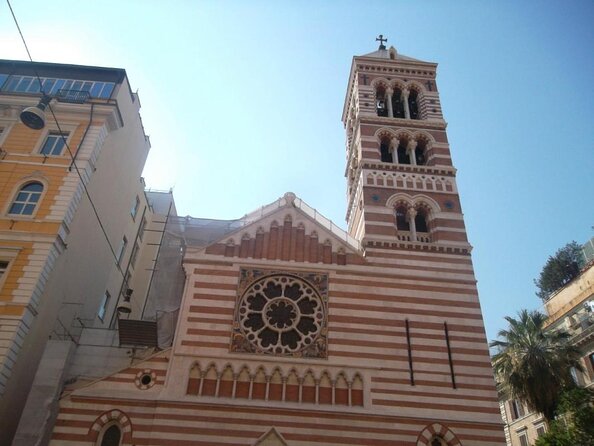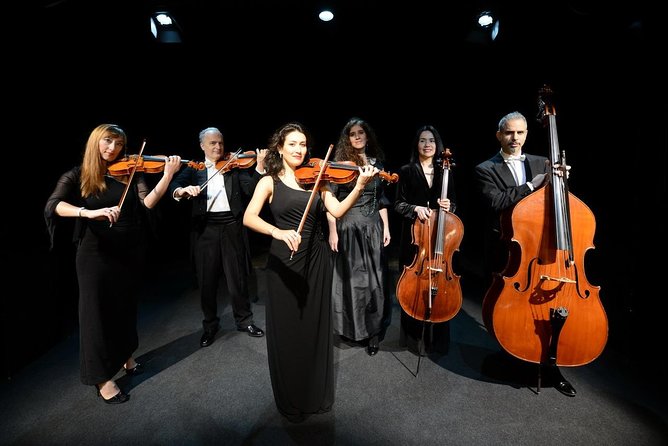Vivaldis Four Seasons Meets Bachs Masterpieces
Within the realm of classical music, a unique convergence unfolds as Vivaldi’s evocative ‘Four Seasons’ meets Bach’s intricate masterpieces. The intertwining of these iconic compositions creates a musical dialogue that transcends time and genre, offering a glimpse into the genius of two Baroque titans.
As audiences enjoy this symphonic encounter, they are beckoned to witness a harmonious blend of styles that illuminates the depth and complexity of these renowned works. Prepare to embark on a sonic journey where tradition meets innovation, promising a musical experience that lingers long after the final notes fade into the ether.
Key Points

- Fusion of Vivaldi’s lively compositions with Bach’s harmonies creates a captivating blend of contrasting styles.
- The combination marks a pivotal moment in classical music evolution, inspiring creativity and complexity.
- Performance interpretations showcase artistic flair, personal emotions, and diverse styles for engaging renditions.
- Vivaldi and Bach’s influence on contemporary music trends is evident in the fusion of classical elements with innovative sounds.
Musical Genius of Vivaldi and Bach

The musical genius of Vivaldi and Bach enraptures audiences with its intricate harmonies and profound emotional depth.
Vivaldi, known for his innovative compositions and virtuosic violin playing, crafted masterpieces like ‘The Four Seasons,’ which vividly portrays the beauty of each season through music.
Bach, on the other hand, was a meticulous composer whose works showcase a perfect blend of technical skill and emotional expression.
Their individual artistic genius shines through in their compositions, each leaving a lasting impact on the world of classical music.
While Vivaldi and Bach didn’t have a direct musical collaboration, their influence on each other and the broader musical landscape of their time is undeniable, setting the stage for future generations of composers to explore and expand upon their groundbreaking work.
Historical Significance of the Composers
In exploring the historical significance of Vivaldi and Bach, one uncovers a rich tapestry of musical innovation and enduring influence that shaped the classical music landscape for generations to come.
Vivaldi, known as the ‘Red Priest,’ was a virtuoso violinist and composer who worked at an orphanage in Venice. His compositions, including ‘The Four Seasons,’ revolutionized the concerto form and showcased his vibrant, emotive style.
On the other hand, Bach, a German composer and organist, came from a long line of musicians. His intricate counterpoint and mastery of harmony in works like the ‘Brandenburg Concertos’ and the ‘Well-Tempered Clavier’ laid the foundation for Western classical music.
Both composers drew inspiration from religious, folk, and dance music of their time, leaving an indelible mark on music history.
A Fusion of Baroque Masterpieces

Bringing together the timeless works of Vivaldi and Bach creates a harmonious fusion of Baroque masterpieces that captivates audiences with its intricate melodies and profound musical depth.
This musical fusion showcases the evolution of the Baroque era, where Vivaldi’s lively compositions meet Bach’s complex harmonies, resulting in a unique and enchanting listening experience.
Vivaldi’s ‘Four Seasons’ with its vivid imagery of nature blends seamlessly with Bach’s masterpieces, offering a blend of contrasting yet complementary styles.
The fusion of these two great composers not only highlights the richness of the Baroque period but also demonstrates the versatility and innovation that continue to influence classical music to this day.
Impact on Classical Music Evolution
With its lasting influence and profound significance, the fusion of Vivaldi’s Four Seasons and Bach’s masterpieces has shaped the evolution of classical music. This blending of two iconic composers’ works marked a pivotal moment in the evolutionary progression of classical music.
The innovative combination of Vivaldi’s vivid imagery in the Four Seasons with Bach’s intricate contrapuntal techniques and harmonic depth contributed to a new wave of creativity and complexity in the classical music landscape. The impact of this fusion reverberated through subsequent generations of composers, inspiring them to push the boundaries of musical expression further.
The seamless integration of these masterpieces not only enriched the repertoire but also set a standard for future compositions, solidifying their place in the annals of classical music history.
Performance Interpretations and Variations
Through diverse performance interpretations and creative variations, musicians breathe new life into the timeless compositions of Vivaldi’s Four Seasons and Bach’s masterpieces, captivating audiences with fresh perspectives and innovative approaches.
-
Musical Interpretations: Artists infuse personal emotions and insights into their performances, offering unique renditions that resonate with listeners.
-
Performance Variations: From tempo modifications to instrument choices, musicians experiment with different elements to bring out distinct qualities in the music.
-
Artistic Creativity: Exploring unconventional techniques and improvisations, performers showcase their artistic flair and individuality in every note.
-
Musical Diversity: Embracing a range of styles and influences, musicians celebrate the richness of classical music through diverse interpretations.
-
Audience Engagement: Through interactive performances and engaging storytelling, artists create immersive experiences that connect with the audience on a deeper level.
Influence on Contemporary Music Trends
Exploring the evolving landscape of music, contemporary trends reflect the lasting impact of Vivaldi’s Four Seasons and Bach’s masterpieces on modern musical expressions. Evolutionary trends in contemporary music showcase a fusion of classical elements with innovative sounds, inspired by the depth and complexity found in Vivaldi and Bach’s compositions.
The intricate harmonies and emotive storytelling present in these masterpieces have influenced a wide array of genres, from classical crossover to experimental electronic music. Contemporary artists draw on the timeless melodies and structural innovations introduced by Vivaldi and Bach, infusing their own creations with a sense of homage and reinvention.
The interplay between tradition and innovation continues to shape the landscape of music, with Vivaldi and Bach’s works serving as enduring touchstones for contemporary influences.
Common questions
What Is the Dress Code for Attending the Evening at the Opera in Rome Featuring Vivaldi’s Four Seasons?
For the evening at the opera in Rome, the dress code leans towards formal attire. Guests should aim for elegance and sophistication, adhering to traditional opera etiquette. This creates a refined atmosphere fitting for the occasion.
Can Children Attend the Opera Performance, and Is There a Special Rate for Them?
Children can attend the opera performance, and there are special rates for them. The opera offers child-friendly activities and ticket discounts, making it a family-friendly experience with youth engagement opportunities. It’s a great way to introduce children to classical music.
Are There Any Intermissions During the Performance, and Are Refreshments Available for Purchase?
During the performance, there are intermission breaks for guests to relax and refresh. Refreshment options are available for purchase during these breaks. Enjoy a seamless experience with opportunities to unwind and indulge.
Is There a Specific Seating Arrangement for the Opera Performance, and Can Special Requests Be Accommodated?
Seating arrangements at the opera are assigned based on the ticket category purchased. While special requests for seating can be made, they are subject to availability. Contact the venue in advance to inquire about accommodating specific needs.
Are There Any Recommended Nearby Restaurants or Attractions to Visit Before or After the Opera Performance?
For pre-show dining, nearby attractions, and opera etiquette, visitors can explore charming restaurants like La Taverna dei Fori Imperiali or sightsee at the Roman Forum. Transportation options include taxis, public buses, or walking.
Last Words
To sum it up, the fusion of Vivaldi’s ‘Four Seasons’ with Bach’s masterpieces creates a symphonic experience that transcends time and resonates with audiences of all backgrounds.
The seamless blend of these iconic composers’ works showcases the depth of their genius and leaves a lasting impact on the evolution of classical music.
From the intricate interplay of strings and keys to the emotional resonance of each note, this orchestral collaboration promises an unforgettable journey through the beauty of Baroque music.